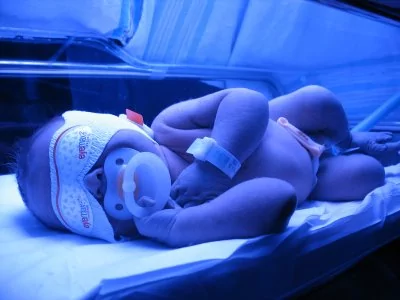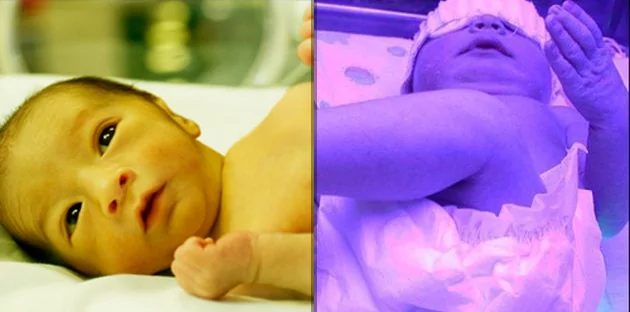By Christie del Castillo-Hegyi, M.D.
The true rates of excessive jaundice and hospitalizations of newborns for phototherapy due to jaundice has been recently published in JAMA Pediatrics published online April 11, 2016. In a study of 104,460 babies born between January 2010 and December 2013 in the Kaiser Permanente Northern California (KPNC) Healthcare System reported than an astonishing 12.4% of babies developed pathological hyperbilirubinemia of greater than 15 mg/dL in the study period, which has been shown in the scientific literature to increase risk of developmental disabilities. This translates to 12,953 babies or almost 12 babies a day. In addition, 5.7% of babies required phototherapy admission, translating to 5954 newborns or 5 babies a day.
California has a state mandate to require Baby-Friendly certification in all its hospitals by 2020, which requires that >80% of eligible newborns be exclusively breastfed at discharge, the primary quality metric of the BFHI. Many California hospitals are working towards that designation and their exclusive breastfeeding rates at discharge are tracked by the California Department of Public Health. Estimates of excessive jaundice in the KPNC hospital system, which has among the highest exclusively breastfeeding rates at discharge, all except 2 reaching the >80% requirement, was described by this study. Seventy-one percent of these hospitalizations were extensions of the original birth admission, which means pathological jaundice was detected before discharge and the newborn’s hospital stay was extended to reduce the pathological effects of bilirubin, namely brain injury.
This is an astonishing number of newborns requiring phototherapy for jaundice as the majority of pathologic jaundice cases are related to dehydration or underfeeding from exclusive breastfeeding, an entity that the Academy of Breastfeeding Medicine calls starvation jaundice. Normally, 100% of bilirubin is removed through the gastrointestinal system carried away by milk or food passing through. When high bilirubin levels are circulating as typical of the newborn period, a small portion of circulating bilirubin can be excreted by the kidneys through urine, a process assisted by phototherapy. Since the majority of bilirubin is excreted through the gastrointestinal system, a newborn who is underfed through colostrum-only feeding can accumulate abnormally high levels of bilirubin in the blood. Underfeeding from early exclusive breastfeeding due to poor latch or, more commonly, insufficient breast milk production, results in hyperbilirubinemia or severe jaundice in exclusively breastfed babies. A minority of babies have increased rates of bilirubin production from blood-type incompatibility, called hemolytic jaundice. Both starvation-related jaundice as well as hemolytic jaundice are improved with supplemental feeding because the primary means by which the body eliminates bilirubin is through milk passing through the intestines.
The original purpose of the paper was to show a decline in phototherapy and pathological jaundice rates in relation to the recalibration of their total serum bilirubin machines showing this may have led to falsely increased rates of hyperbilirubinemia diagnoses and hospitalizations. Before the recalibration, 20.4% of babies were diagnosed with hyperbilirubinemia of > 15 mg/dL and the total phototherapy hospitalization rate was 13.2% (extended plus repeat hospitalizations). The phototherapy rates went from 13.2% to 5.7%.

Newborns diagnosed with hyperbilirubinemia and hospitalized for phototherapy before and after calibration. The raw numbers show high rates of phototherapy admissions even after calibration.
The KPNC system has the highest exclusive breastfeeding rates at discharge in California according to 2014 data from the California Department of Public Health. Similar trends were found in 2013, within the time period examined by the study, which reported Kaiser Walnut Creek and Kaiser Oakland as having the highest exclusive breastfeeding rates at discharge of 97.5% and 95%, respectively. Considering that an estimated 22% of mothers have delayed lactogenesis II, which puts her newborn at risk for excessive weight loss and hyperbilirubinemia, a 95-97.5% exclusive breastfeeding rate predictably results in complications and hospitalizations occurring to 6-12% of newborns, as confirmed by this study. Once again, this study shows complications and hospitalizations for jaundice and dehydration are COMMON and occur at high rates in Baby-Friendly-compliant hospitals. 1 in 17 babies are hospitalized for jaundice and 1 in 8 experience levels of hyperbilirubinemia that increases risk for developmental disabilities. “Baby-Friendly” is in fact, NOT baby-friendly. Fed is best.
Link to JAMA Pediatrics article:
https://drive.google.com/open?id=0B0_MbXCqYazzSk1yYzNWM0hxT2M
[Blog corrected 8/31/2018 to reflect the accurate designation status of the KPNC hospitals and their exclusive breastfeeding rates. The blog was also corrected with regard to the analysis of the true percentage of babies at a Baby-Friendly compliant hospital system showing the number of babies developing hyperbilirubinemia and those requiring phototherapy admissions.]


I'm so glad I found this post. I supplemented and feel better about my choice.
I would be concerned about supplementing formula and opening the gut to unfiltered proteins. Why not recommend donor breastmilk if the milk is late coming in?
We recommend donor breast milk if it is bank milk tested, it is available and a mother chooses it.
Why is there not been more studies on breastfeeding ??? Why push formula which can cause allergies and delay as well? Not to mention formula can lead to all sorts of health compilations later in life like obsity diabetes and many more. Making a mother feel breastfeeding will cause her baby to have a longer hospital stay and can lead to health problems early on is ridiculous!! How about more people learn how to help the mother and her baby to properly latch and make it easier to get donated breast milk!!! Formula should never ever be the first option to a mother who wants to breastfeed her baby!!
If there is no milk, no matter how much breastfeeding education and how perfect the latch, a child will be underfed and develop dangerous levels of jaundice. The key is assessing whether or not a mother’s milk is sufficient to safely feed her baby exclusively. If there is not enough milk, supplementation with safe, test donor breast milk or formula is the only way to prevent excessive jaundice.
If a mother wants donor milk, I support that but many mothers do not want donor milk. There is no science that supports that formula has anything to do with gut health. In fact, it has been shown that babies exposed to cow's milks within the first 2 weeks of life have a 19-fold lower risk of developing cow milk allergy that those who were exposed >2 weeks of age.
My daughter had jaundice which caused her to want to sleep a lot when I brought her home. I pumped and fed her breast milk with a syringe at 3 days old. It helped her jaundice tremendously.
My daughter had jaundice which caused her to want to sleep a lot when I brought her home. I pumped and fed her breast milk with a syringe at 3 days old. It helped her jaundice tremendously.
Some mothers do not have milk and making her fear formula supplementation, when that may be the only option for her to feed a hungry, dehydrated and hypoglycemic baby is what is causing babies to become hospitalized. The idea that all breasts produce enough milk as long as a mother tries enough is a lie of the breastfeeding industry. The idea that formula causes allergies is also a lie and has been debunked by multiple studies performed by allergists. One such study of over 13,000 children found that early introduction of cow's milk (<2 weeks of age) DECREASED the risk of cow milk allergy by 19-fold. There are many myths and lies propagated by breastfeeding advocates that threaten the lives of newborns and perpetuate a silent epidemic of newborn and infant starvation that they like to sweep under the rug. Mothers are speaking out against it. Fed is Best.
One quick way for a new mom to tell if she is producing colostrum in the early hours after delivery is to use a nipple shield. I know they are a no-no in the breast feeding manuals but if your baby is hypoglycemic you can use it once and see if there is any colostrum on the inside of the shield. I did and this reassured me they was was some production going on. Neither of my girls developed jaundice but they both cried constantly, didn't sleep and wanted to nurse continuously. They both were diagnosed with reflux and colic but weight gain was okay.
I guess my point is, I agree that reading all these breastfeeding manuals definitely had my mind set against supplementation and that's a shame because things could have gone differently for us! Fed is best
I’m so impressed with the quality of this article. It’s clear that a lot of time and effort went into creating it. The information is accurate, up-to-date, and extremely helpful. Thank you for sharing your knowledge with the world.